The varieties of peppers are unequal! The bite of a great pepper is sweet, spicy, and vegetal; nothing compares. Many varieties of amazing fresh peppers may be found worldwide at grocery shops and farmer’s markets.
This helpful guide to different varieties of peppers will help you discover some of the world’s most wonderfully hot and delightful peppers!
1. Bell pepper

Scoville index : 0
Bell-shaped peppers are relatively large and have a slightly bitter flavour when they are immature. It gets progressively sweeter and brighter red as it ages. Purple, pink, orange, white, yellow, and white variants are also available. Bell peppers infuse any meal with moisture due to their high water content. You may also apply colour to them.
2. Mini Sweet Pepper

Scoville index : 0
These little peppers are smaller, have fewer seeds to remove, and are frequently mildly sweeter than bell peppers in appearance and flavour. As with bell peppers, you can roast or sauté them or use them as scoops for your favourite dip.
3. Jimmy Nardello
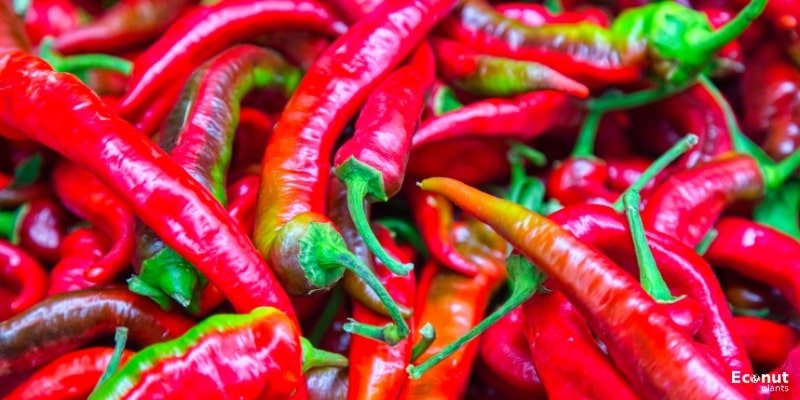
Scoville index : 0 – 100
The Nardello family introduced the eye-catching pepper known as “Jimmy Nardello” to the United States in 1887 from Italy. Each crimson, elongated, and skinny pepper grows 6 to 12 inches long and is bursting with taste.
One of the most adaptable peppers on this list is “Jimmy Nardello,” which may be eaten fried, grilled, or raw in salads. It also works well as ground, dried paprika.
4. Shishito

Scoville index : 50- 100
Southeast Asia is the original home of these tiny green peppers. Even though they range in heat from mild to moderate, depending on the SHU score, so don’t be shocked if you bite into one and find that it’s hotter than you anticipated. These can be eaten raw, but we think they taste best roasted or even deep-fried and served as an appetizer.
5. Banana Pepper
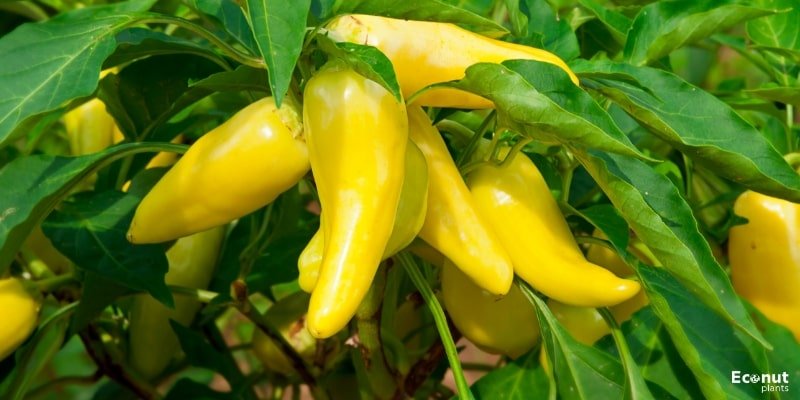
Scoville index : 0 – 500
One of America’s most well-liked and mildest sweet peppers is the yellow banana pepper. It is mildly sweet, crunchy, pale yellow, and just the right amount of mellow for a small child to eat while it is young, gets softer and sweeter as it ripens from orange to red.
It is delicious at any growth stage, so have a bite whenever you feel like it. Great pickled, but save some for stuffing or stir-frying.
6. Beaver Dam

Scoville index : 500–1,000
In 1912, this Hungarian variety was introduced to Beaver Dam, Wisconsin. These peppers are excellent for making slightly spicy stuffed peppers because they are mildly fiery.
7. Poblano
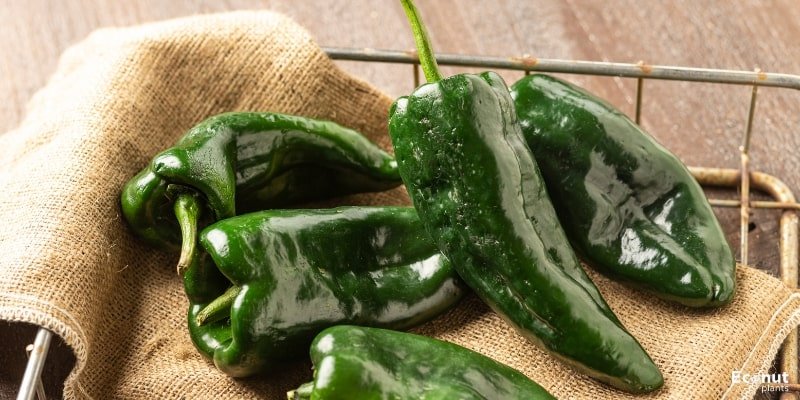
Scoville index : 1,000 to 2,000
The traditional stuffing pepper in Mexico is the big, mildly spicy poblano. Certain varieties develop from a rich green to a mahogany hue, while others reach a rich brown in maturity. Ancho chilies, which are used in cooking sauces and moles, are made from wrinkled, dark brown peppers that are dried.
8. Alma Paprika
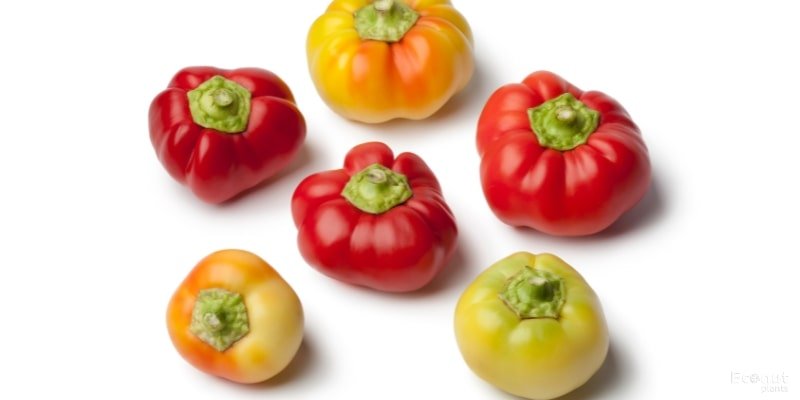
Scoville index : 1,000–3,000 SHU
Grown in Hungary and other Eastern European countries, Alma paprika peppers are a bright red cultivar of Capsicum annuum. Due to their mild heat and rich, sweet flavour, these peppers are well-suited for enhancing the flavour and colour of food without overpowering the palate with spice.
A common element in Hungarian paprika, which is used extensively in traditional goulash and other savoury foods, is alma paprika peppers, which are dried and ground into a fine powder.
9. Hot Cherry Pepper
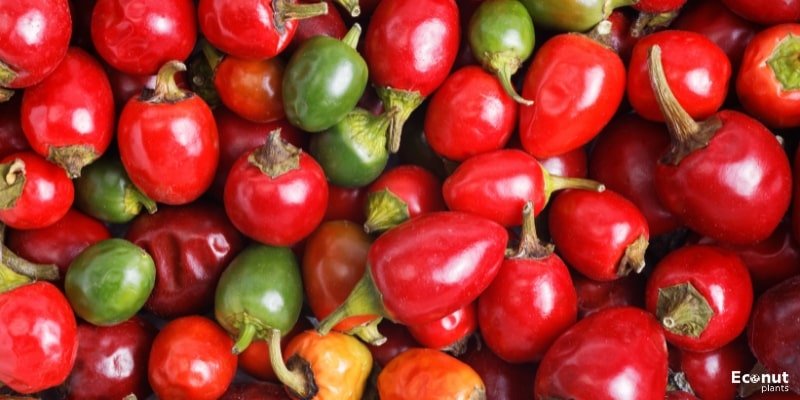
Scoville index : 2,500 to 5,000
The somewhat hot cherry pepper, round, red, and small in size, resembles the sweet peppadew and pimento in appearance. Similar to peppadew and pimento, the somewhat hotter cherry pepper is typically pickled and used as a sandwich topping, on charcuterie platters, and in antipasto dishes.
10. Jalapeño Pepper
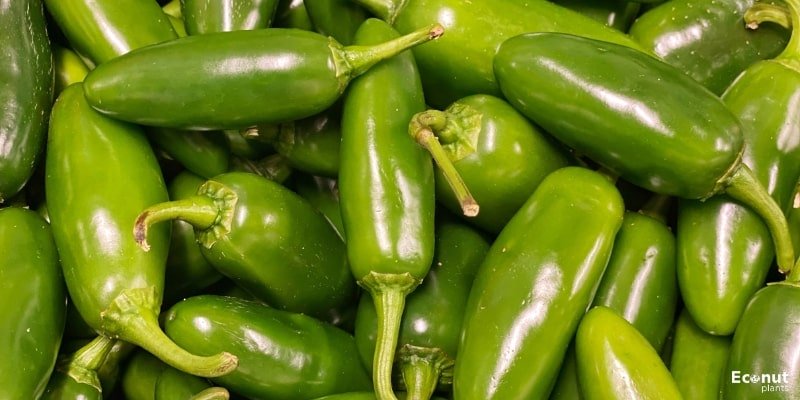
Scoville index: 2,500–8,000
The jalapeño, a fiery pepper with glossy green skin, is a familiar and beloved pepper among hot heads. Jalapeños are relatively low on the Scoville scale, but that doesn’t imply they’re not spicy.
You can reduce the amount of spice by removing most or all of the seeds and membrane, which are the main sources of heat.
11. Fresno Pepper
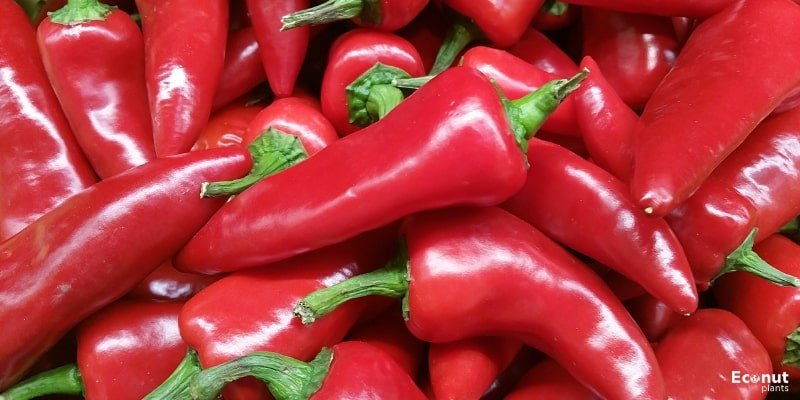
Scoville index : 2,500 – 10,000
Although they resemble a red jalapeño, they have a little bit more spice and are often a bit more complex. When fresnos age, their flavour becomes a little more fruity and smoky. Try these if you’re seeking to change things up.
12. Pot-a-Peno
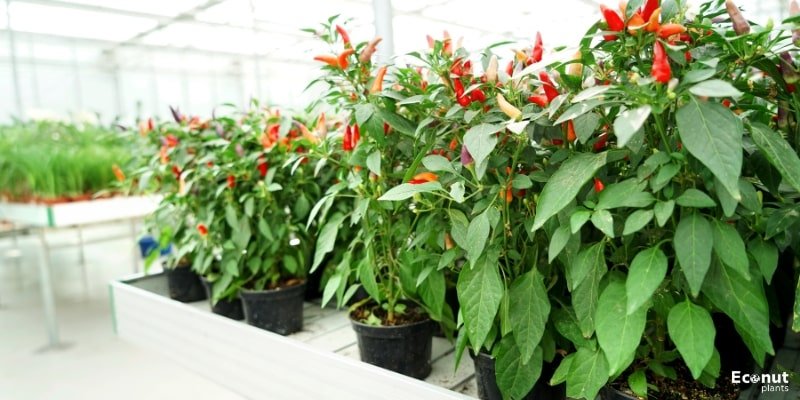
Scoville index : 5,000
This jalapeño hybrid is ideal for compact places because it fits well in containers. Mildly hot green peppers can be harvested in 45 to 50 days, or you can wait for them to turn red and then considerably spicier in 60 to 65 days.
13. Red Rocoto
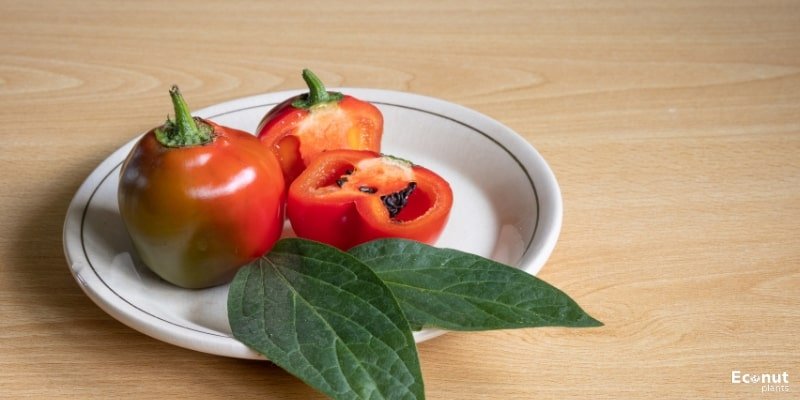
Scoville index : 30,000–10, 00, 00
The typical pepper of the C. pubescens species is the plump, black-seeded, highly spicy rocoto. They are puréed with tree tomatoes (tamarillos) to form a delectable dipping sauce for fried fish, and they are used in ceviches by Bolivian and Peruvian chefs.
14. Bulgarian Carrot
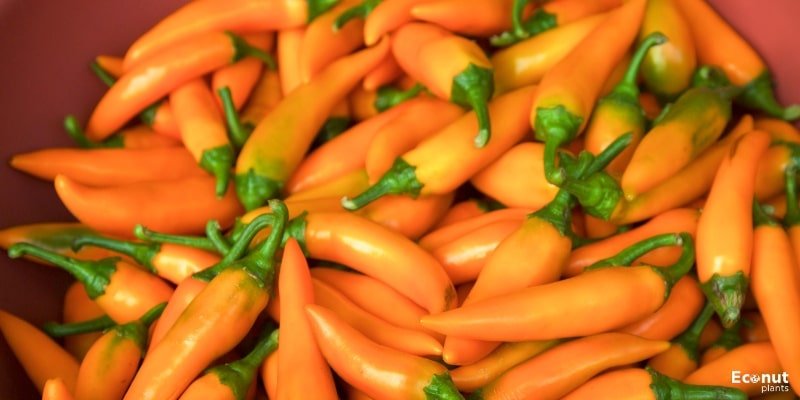
Scoville index : 5,000–30,000
These peppers are yellow-orange in colour and shape, and they taste quite spicy but tasty, like 3-inch-long carrots. They are a great complement to chutneys.
15. Cayenne Pepper

Scoville index : 50.000
The department capital of French Guiana in Central America, Cayenne, is referred to by the name.
The most common name for this type of pepperoncino is cayenne pepper, since it is typically used dry or freshly collected, toasted, and then ground. Growing and harvesting it is a global phenomenon, with Italy being one of its growing locations due to its popularity.
It can be anywhere from 2 to 5 cm long and has a vivid red hue. Rich in potassium, alcium, beta-carotene, vitamins A, C, and E, and capsaicin, it is mostly used in the kitchen as ground pepper.
16. Thai Hot Peppers

Scoville index : 50,000-100,000
Depending on the variety, the height of these extremely spicy pepper plants can range from 12 to 30 inches. One plant that would be perfect for a patio planter is Burpee’s Thai Hot Pepper, which grows to only about a foot tall when fully mature and produces small, inch-long peppers.
It can be planted on the ground or in a container. Burpee’s Big Thai Hybrid produces 4-inch peppers on 30-inch-tall plants. About seventy days after transplanting, Thai peppers are ready to be picked.
Fresh Thai chili peppers can be consumed, or they can be crushed and used in sauces or preserved in vinegar or oil. Cook with them sparingly because they are about 25 times hotter than a typical jalapeño.
17. Scotch Bonnet Pepper
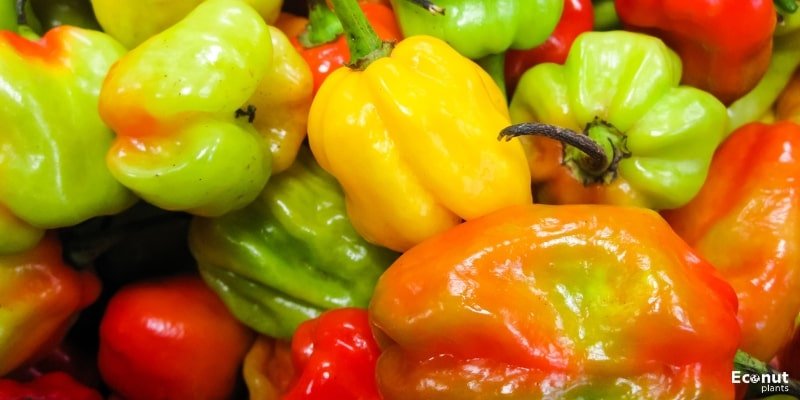
Scoville index : 100,000 – 0350,000
This small pepper is a firecracker and is the preferred hot pepper in the Caribbean. These peppers are plump and have wrinkled skin, yet they have a strong flavour. Not only are they spicy, but they have a very subtle fruity and sweet flavour as well. They are used in jerk-style foods and in Caribbean pepper sauces.
18. Pot Brown
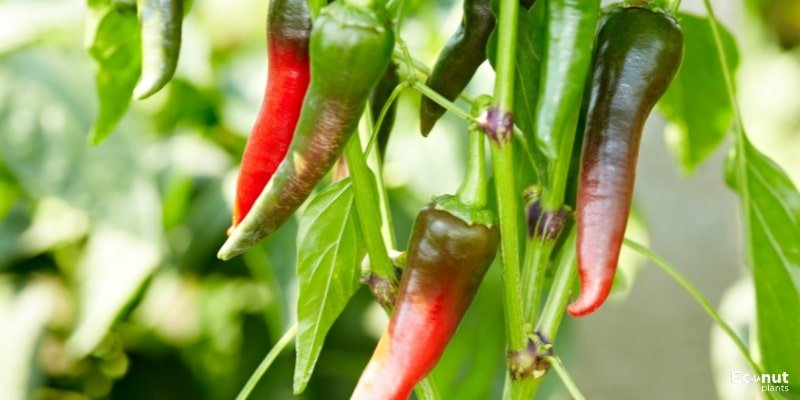
Scoville index : 100,000 – 350,000
This pepper is a relatively recent addition to the Trinidad 7-Pot superhot pepper lineup. The inside membrane that covers most of the pepper’s interior is white, while ripe pods are brown in hue.
19. African Bird’s Eye

Scoville index : 1, 75,000
African bird’s-eye peppers are small, hot peppers with vivid colours that grow wild in Africa. They are often used in soups, hot sauces, and other dishes. The African Bird’s Eye, often referred to as Piri Piri or Pili Pili, is a tiny chili that grows to only about 1 inch in length, yet it packs a powerful punch.
They feature a blunt end and a tapering shape that reaches red or purple when they grow. Originally discovered in the wild in Africa, it has recently been cultivated commercially in a few regions of the continent, frequently for organic pest management or as a pepper extract.
20. Ghost Pepper

Scoville index: 60, 00, 00 – 1,041,427
The ghost pepper, often called the bhut jolokia, is extremely hot. The pepper, which comes from Northeast India and gets its name from the language’s term for “ghost,” was once the hottest pepper in the world, according to the Guinness Book of World Records.
Ghost peppers are tiny, crimson, wrinkled peppers with a delicious, smoky flavour blended in with all that (agonizing!) heat. Owing to their extremely high SHU content, ghost peppers are uncommon in restaurant and home recipes.
However, they can be found at some grocery shops and, with the right safety precautions and protective gear, they can be turned into hot sauce or extremely spicy salsa.
21. Aji Chombo
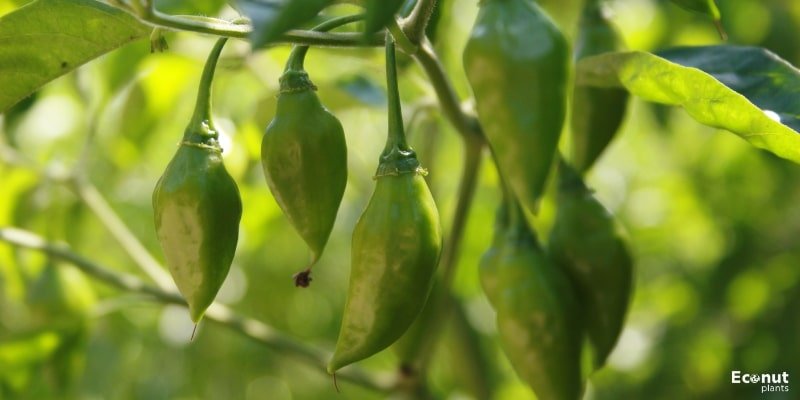
Scoville index : 50,000 to 100,000
The popular chili variety Aji Chombo, sometimes called Panamanian Hot Peppers, is indigenous to Panama and other Central American nations. These little hot red peppers are extremely hot; they typically have a Scoville Heat Index of 50,000 to 100,000.
The extreme spiciness of Aji Chombo peppers lends a bold and distinct taste to a variety of classic Panamanian recipes, such as hot sauces, stews, and marinades.

